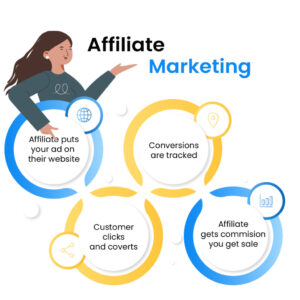Picture this: you recommend a great movie to a friend and they end up watching it. Now, imagine you got paid because they enjoyed your recommendation. That’s pretty much how affiliate marketing works, but with products or services. It’s all about earning a commission by promoting someone else’s stuff.

In the world of affiliate marketing, you’ll often hear terms like ‘affiliates’, ‘advertisers’, and ‘consumers’. Affiliates are the folks who promote products; advertisers are the ones offering the products, and consumers are the ones buying. It’s like a chain reaction where everyone benefits, when done right.
click here to start your own online business for free Ced0224
Imagine walking into a store. The salesperson helps you find what you need and earns a little bonus from the sale. In affiliate marketing, affiliates are like those helpful salespeople, but online. They guide potential buyers with expert opinions or fun blogs.
The affiliate marketing ecosystem is a well-oiled machine. Advertisers provide products or services, affiliates promote them to reach a broader audience, and consumers purchase the products, thereby completing the cycle. It’s a win-win-win setup.
Think of this as a straightforward retail analogy: affiliates are like the bridge between the product and the customer, helping people find what they’re looking for while gaining a reward themselves. It’s a simple and effective way to understand affiliate marketing basics.
Common Terminology in Affiliate Marketing: Simplified
Affiliate marketing comes with its own set of buzzwords that might sound confusing at first, but they’re actually pretty straightforward when you break them down.
Take the term ‘cookie’ for instance. In simple terms, a cookie in affiliate marketing is like a digital memory that remembers what online behavior a user had. When someone clicks on an affiliate link, a cookie drops in their browser so that if they come back later and make a purchase, the affiliate gets credit for that sale.

Then there’s ‘conversion rate’. This just tells you how many people followed through with an action, like making a purchase, after clicking on an affiliate link. It’s a percentage that shows how effective your marketing efforts are.
Terms like CTR (Click-Through Rate) and CPA (Cost Per Action) are also important. CTR tells you how many people are clicking your links. CPA is a payment model where affiliates get paid for specific actions, like sales or sign-ups.
Affiliates often hear about tools like affiliate programs, networks, and links. Programs are the individual partnerships with specific brands. Networks are bigger platforms connecting affiliates to many programs, kind of like a middleman. Links are the special URLs that track all those clicks and credits.
A critical term is EPC, or Earnings Per Click. It’s like a report card showing how much money you make on average every time someone clicks your affiliate link. It’s vital for figuring out how well you’re doing and making necessary adjustments accordingly.
All these terms might seem overwhelming, but once you get a handle on them, you’ll navigate affiliate marketing like a pro. It’s about speaking the language, so you can sell better.
Unpacking Affiliate Networks and Programs
Affiliate networks and programs form the backbone of affiliate marketing. So what’s the difference between the two? An affiliate network is a platform that serves as a bridge connecting affiliates with various advertisers. Imagine a marketplace where different brands offer their affiliate programs, and you get to pick which ones to promote.
Now, let’s talk about the terms you might hear. ‘Merchant’ and ‘advertiser’ often refer to the same entity—the one offering a product or service. ‘Affiliate manager’ is the go-to person who supports affiliates and ensures things run smoothly.
The affiliate program is an individual deal between you and a merchant. These programs are where you agree on things like commission rates, payment methods, and marketing rules. Networks, on the other hand, are larger platforms that offer multiple programs—kind of like having a whole catalog to choose from.
Choosing the right network can be crucial. A good network provides reliable tracking, prompt payments, and support. It’s about finding a platform where the relationships align with your marketing goals.
To be successful, understanding these structures helps in

choosing partners that match your style and audience, ultimately guiding your marketing strategies in the right direction. It’s about building a partnership that works for all parties involved.
Performance Analytics and Tools: Decoding the Jargon
Tracking success is a key part of affiliate marketing. Without it, you’re flying blind. Performance analytics help you know what’s working and what needs fixing.

KPIs, or Key Performance Indicators, are metrics that show how well your affiliate campaigns are doing. Common KPIs include traffic, which tells you how many visits your links generate, and revenue, which is the money you’re raking in from those visits.
Let’s simplify some other metrics. Revenue is pretty straightforward; it’s the income you earn. ROI, or Return on Investment, is a snapshot of how much profit you’re making compared to what you’re spending. The goal is to keep it positive—meaning you’re earning more than you’re spending.
Traffic and revenue numbers offer insight into the effectiveness of your campaigns. They help you tweak strategies for better results. More visits don’t necessarily mean more revenue, so always aim for quality traffic that converts.
Many tools can help you analyze these metrics. Platforms like Google Analytics or specialized affiliate tracking software can offer in-depth insights. They allow you to see where your traffic comes from, how long people stay, and what actions they take. This valuable information guides you to refine your strategy and maximize earnings.
Legal and Ethical Aspects of Affiliate Marketing
Understanding the legal side of affiliate marketing is just as important as mastering its terms. It involves knowing about things like commissions, payouts, and how they work. Commissions are the earnings you receive per sale or action, while payouts refer to how often you’ll receive these earnings—it’s crucial to know these details before jumping in.
Following guidelines, like those set by the Federal Trade Commission (FTC), ensures you maintain transparency and honesty in your marketing. The FTC requires affiliates to disclose their financial relationships with merchants to consumers. Think of it like a heads-up for your audience, so they’re aware there’s a partnership behind the promotion.

Handling ‘cookie consent’ and privacy policies can be tricky but necessary. Cookies, as explained earlier, track user activity, so ensuring users consent to cookies is important, especially in today’s privacy-conscious environment. It’s about respecting user privacy while still gathering the data you need.
Being transparent builds trust with your audience and merchants. When customers know they’re getting genuine recommendations rather than just sales pitches, they’re more likely to trust your brand and return for more advice.
In affiliate marketing, staying on the right side of legal and ethical guidelines can be a powerful way to build long-term success. It’s a mix of honesty, transparency, and respect that leads to sustainable growth and partnerships.
